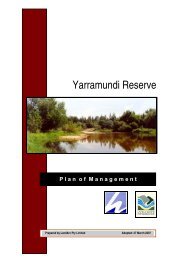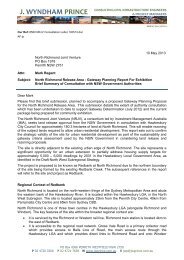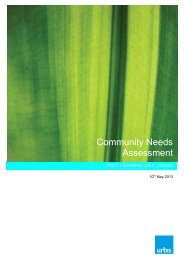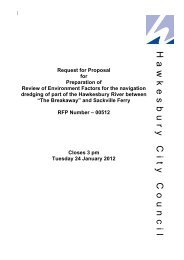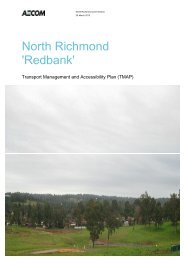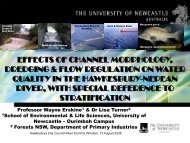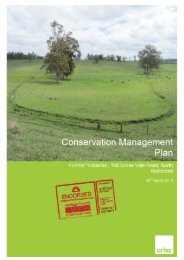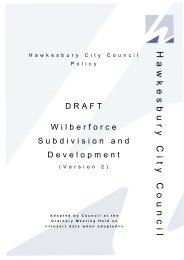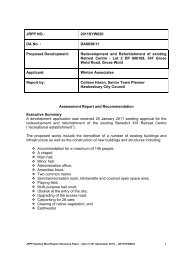Attachment 1 to Item 53 - Roadside Vegetation Management Plan
Attachment 1 to Item 53 - Roadside Vegetation Management Plan
Attachment 1 to Item 53 - Roadside Vegetation Management Plan
You also want an ePaper? Increase the reach of your titles
YUMPU automatically turns print PDFs into web optimized ePapers that Google loves.
H AW K E S B U R Y C IT Y C O U N C IL R O AD S ID E V E GE T AT ION M AN AG E M E N T P L AN<br />
The definition of a roadside environment in this <strong>Plan</strong> differs from that used by the NSW <strong>Roadside</strong><br />
Environment Committee, formed in 1994 and comprised of 11 organisations representing bodies<br />
responsible for managing roadsides and other linear reserves in NSW. The Committee has defined a<br />
roadside environment as “that area adjacent <strong>to</strong> the road and extending <strong>to</strong> a maximum distance of 20m<br />
from the edge of the road surface but specifically excluding areas of private land within this proximity”.<br />
The definition, as used in this <strong>Plan</strong>, is preferred over that defined by the NSW <strong>Roadside</strong> Environment<br />
Committee as HCC must consider the whole context of the road environment within which it is working<br />
where its activities may have an impact. It is not constrained by a maximum distance of 20m.<br />
1.4 IMPORTANCE OF ROADSIDES<br />
<strong>Roadside</strong> environments comprise a diverse range of environmental, economic, social and heritage<br />
values and provide a range of beneficial environmental and ecosystem services. In NSW, they<br />
comprise around 5 % of the <strong>to</strong>tal land area of NSW, which, when combined with travelling s<strong>to</strong>ck routes<br />
and reserves, is almost equivalent <strong>to</strong> the <strong>to</strong>tal area of National Parks in NSW (NSW <strong>Roadside</strong><br />
Environment Committee).<br />
The values and services provided by well-managed roadside environments have been documented in<br />
many other RVMPs and roadside environment management strategies (notably the Hunter Councils<br />
<strong>Roadside</strong> Strategy; HCCREMS 2007, and the Casey <strong>Roadside</strong> <strong>Vegetation</strong> <strong>Management</strong> <strong>Plan</strong>; Ecology<br />
Australia 2002), as well as other sources (Forman et al. 2003). Some of the key values and services<br />
provided by well-managed roadside environments include:<br />
Biodiversity conservation: In many areas roadside environments may contain the primary source of<br />
remnant native vegetation, seed and wildlife habitat due <strong>to</strong> previous logging and clearing practices in<br />
the surrounding landscape. Even in less heavily cleared landscapes, remnant roadside vegetation<br />
often provides important links between larger patches of habitat that enable the movement of fauna<br />
species between these areas, thus contributing greatly <strong>to</strong> their ongoing survival.<br />
Conservation of items of cultural & his<strong>to</strong>rical significance: <strong>Item</strong>s of cultural, his<strong>to</strong>rical or Aboriginal<br />
significance are often located in roadside environments. The appropriate management of these<br />
environments can therefore play an important role in the protection of these his<strong>to</strong>rically and culturally<br />
significant items. Examples of Aboriginal cultural heritage items that may be found within the roadside<br />
environment include middens and scar trees, while items of European heritage may include his<strong>to</strong>rical<br />
sites or monuments, such as the routes of early explorers and settlers, or bridges.<br />
Waterway and catchment health, and conservation of adjacent ecosystems: The quality and<br />
quantity of water runoff from roads can have a significant impact on the quality of downstream<br />
waterways and adjacent ecosystems. Well vegetated roadside environments and appropriate road<br />
construction, maintenance and drainage practices and systems can play a significant role in reducing<br />
the extent of sediments and other pollutants that are discharged in<strong>to</strong> local waterways from both sealed<br />
and unsealed road surfaces. They can also provide an effective buffer against edge effects and<br />
disturbance fac<strong>to</strong>rs including weeds and sediment runoff that would otherwise degrade these<br />
environments.<br />
Aesthetic, and amenity values: <strong>Roadside</strong> vegetation contributes considerably <strong>to</strong> the natural and rural<br />
amenity of the landscape. In addition <strong>to</strong> breaking the mono<strong>to</strong>ny of overly cleared landscapes, well<br />
vegetated roadsides soften the harshness of the road environment and provide points of interest for<br />
mo<strong>to</strong>rists. They also provide shelter and shade for lives<strong>to</strong>ck, reduce the impacts or strong winds and<br />
reduce the impacts of noise and dust (from unsealed roads) on adjoining land owners and residents.<br />
© E C O L O G I C AL AU S T R AL I A P T Y LT D<br />
2



